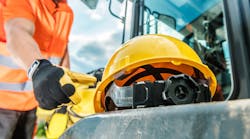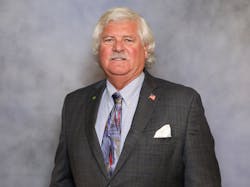Bradley D. Giles, president of Bradley Giles and Associates, has spent most of his 40-year career in construction and mining. His long association with the safety profession was influenced by family tragedies, as both his grandfather and great-grandfather died in mining incidents. Since joining the American Society of Safety Professionals (ASSP) in 1981, he has received the President’s Award twice and was honored as an ASSP Fellow in 2010. He took the reins as the association’s 107th president on July 1, 2021.
EHS Today talked with Giles about safety’s expanded role due to the pandemic and his plans for ASSP going forward.
EHS Today: What are your thoughts on how the profession dealt with the pandemic?
Bradley Giles: In the past 16 months, the true value of the safety professional came through. How we as safety people handled the pandemic made me very proud. Let’s remember EHS professionals had their day jobs, analyzing hazards and health issues, and then they had to create COVID-19 protocols. They had to protect employees, their families and also the community—all the while keeping the doors open for business.
Communication, which is the foundation of how safety people perform their jobs, came through loud and clear. We explained to our colleagues both what was going on and what tools were needed, such as screening and contact tracing. We set up teams A and B so that we were covered if something happened to one team.
This economy is in the good shape it is now largely due to the efforts of safety professionals.
What best practices adopted during the pandemic do you see being carried forward?
Giles: The biggest change, of course, is how work was done. We had to create new ways to accomplish the necessary work with fewer people at physical locations. We needed to adapt our scheduling, ensure that we had the right resources and devise a planning process. Most importantly, we had to communicate the why of what was being done. Prior to the pandemic, employees were basically provided with directions and sometimes didn’t complete them. But by explaining why things needed to be done, it helped people better understand the process. There was a dialogue, and things were executed better.
“This economy is in the good shape it is now largely due to the efforts of safety professionals.”—Bradley Giles, ASSP
The level of autonomy changed as well. Instead of having colleagues right down the hall, management had to trust people to do their jobs. A lot of surveys show that during the pandemic, people were more productive than before. Moving forward, I see a lot of companies using a hybrid working schedule of three days working remotely and two days in the office. The important consideration now will be what works best for the individual, and I see this continuing as we move forward.
Do you view mental health awareness as a safety issue?
Giles: Yes. More than ever, we are looking at the total worker health, and mental health is certainly an important component. We need to look at how the employee functions at home and at work. What pressures are they under? How do we help with this so that they don’t come to work in a condition that could lead to safety issues?
We also need to understand the job pressures that can lead to mental health issues. One striking example is the high suicide rate of construction workers. It’s just atrocious. We must figure out ways to get this group of very hardworking people the help they need. That’s not always easy as they are on the road, away from home and [participating in] specific programs. We need to have an open door so we can be the facilitator who provides resources to address this particular issue. That is also true for the opioid crisis workers are facing. I believe that [Employee Assistant Programs] EAPs are a good mechanism for helping employees with health issues as they are third-party providers, and often people don’t feel comfortable going to a boss or supervisor with these issues.
As diversity, equity and inclusion initiatives are increasing in all areas of life, do you consider these a concern for the safety profession?
Giles: Yes. The profession has to be more inclusive so we can have a variety of perspectives and input, leading to a safer workplace. We looked at ourselves and saw that we need to be more diverse, as does our profession.
Late last year, ASSP formed a task force on the issues, and 80 people volunteered to help. The task force of 12 is diverse across all areas—race, gender, age, etc. Safety people are here to take care of every employee, and we need to transcend any biases.
Furthermore, we need to support diverse groups as well. For example, [personal protective equipment] PPE and ergonomics haven’t caught up to the increased number of women we have in our organizations. We also need to adapt better [for] those who have other challenges. We need to find new ways to bring a wider variety of people into our profession.
As ASSP president, what are your goals for the profession?
Giles: First, I want to build upon the value that organizations have placed on our profession. As a profession, we came into our own this past year. We worked with all levels of these organizations, and that needs to continue. I firmly believe that if you put a company’s resources into safety in a similar manner to what is allocated for other areas of the company, it will lead to both less injuries and increased productivity.
Increased safety is good for business in general. I recently was told about a large company that begins investor calls with safety metrics. When asked by investors why they start with those, the company responded that if they can manage the safety concerns, they can manage the rest of the business well.
My second goal is the look at the talent pipeline and make sure that we can fill it. A [National Institute for Occupational Safety and Health] NIOSH study done in 2020 said that employers plan to hire almost 25,000 EHS professionals over the next five years. This number is double the number of students who will be graduating in our profession.
We need to look for other sources, such as people who have been in the trades and would be interested in our field. Veterans are another potential source of employees. We have always been a profession that has drawn from other disciplines—more than 50% of those current employed in the field came from other areas, such as education, human resources, engineering and business. What draws people to our profession is the desire to work with others in an environment where you can affect and work with all parts of the organization.
We also want to continue to build on the education we offer the profession—I see this as the central role that our organization provides. In addition to certification processes, we are exploring several other educational opportunities. Introducing virtual learning is a good case in point. Over 70% of the participants in our Safety2020 annual conference, which was virtual, were new to the conference. Going forward, we will always offer virtual components for meetings and events. I also see expanding education into offerings that explore the business aspects of an organization, which haven’t always been taught to EHS professionals. For example, courses that can help EHS professionals understand business strategies, budgets and how to communicate across the organization.
As we have learned during the pandemic, EHS professionals’ value has increased in both awareness and importance, and our essential role will continue to grow for the benefit of both employees and the organization as a whole.


